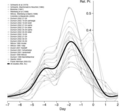ไฟล์:The Fertile Window.png
ไม่รองรับเนื้อหาของหน้าในภาษาอื่น
จากวิกิพีเดีย สารานุกรมเสรี

ขนาดของตัวอย่างนี้: 648 × 600 พิกเซล ความละเอียดอื่น: 259 × 240 พิกเซล | 519 × 480 พิกเซล | 830 × 768 พิกเซล | 1,106 × 1,024 พิกเซล | 1,806 × 1,672 พิกเซล
ดูภาพที่มีความละเอียดสูงกว่า (1,806 × 1,672 พิกเซล, ขนาดไฟล์: 1.27 เมกะไบต์, ชนิดไมม์: image/png)
| รูปภาพหรือไฟล์เสียงนี้ ต้นฉบับอยู่ที่ คอมมอนส์ รายละเอียดด้านล่าง เป็นข้อความที่แสดงผลจาก ไฟล์ต้นฉบับในคอมมอนส์
|
ความย่อ
| คำอธิบายThe Fertile Window.png |
English: The Fertile Window or Fertility Window, marks the eight days with the highest chance of getting pregnant during a woman's menstural cycle when having intercourse. It is also known as targeted intercourse and it is used in fertility awareness methods. The Fertile Window typically ranges from day -7 to day +2 with day 0 as the ovulation date. Although not all studies have found couples getting pregnant every day during this time, it typically spans to approximately 8 days, from day -6 to day +1 from the ovulation date. The average chance of getting pregnant during this 8 days interval is typically higher than 2%. The Fertile Window (FW) or chances of getting pregnant can be affected by many factors including age, health, sleep, etc. Thus, even though the span of 8 days is normal, the height (or probability) in this chart can be lower or higher.
References: a) Schwartz, Daniel, et al. "Donor insemination: conception rate according to cycle day in a series of 821 cycles with a single insemina on." Fertility and sterility 31.2 (1979): 226-229. b) Schwartz, D., P. D. M. MacDonald, and V. Heuchel. "Fecundability, coital frequency and the viability of ova." Popula on studies 34.2 (1980): 397-400. c) Bremme, J. Sexualverhalten und Konzeptionswahrscheinlichkeit. Diss. Med Disserta on, Universität Düsseldorf, 1991. d) Weinberg, C. R., et al. "The probability of conception as related to the ming of intercourse around ovula on." Genus (1998): 129-142. e) Wilcox, Allen J., Clarice R. Weinberg, and Donna D. Baird. "Post-ovulatory ageing of the human oocyte and embryo failure." Human Reproduc on 13.2 (1998): 394-397. f) Colombo, Bernardo, and Guido MasaroIo. "Daily fecundability: -rst results from a new database." Demographic research 3 (2000). g) Dunson, David B., Bernardo Colombo, and Donna D. Baird. "Changes with age in the level and duration of fertility in the menstrual cycle." Human reproduc on 17.5 (2002): 1399-1403. h) Wilcox, Allen J., Clarice R. Weinberg, and Donna D. Baird. "Timing of sexual intercourse in rela on to ovula on—eOects on the probability of concep on, survival of the pregnancy, and sex of the baby." N Engl J Med 1995.333 (1995): 1517-1521. i) Dunson, D. B., et al. "Assessing human fertility using several markers of ovula on." Sta s cs in medicine 20.6 (2001): 965-978. j) Dunson, David B., et al. "Day-speci-c probabili es of clinical pregnancy based on two studies with imperfect measures of ovula on." Human Reproduc on 14.7 (1999): 1835-1839. k) Stanford, Joseph B., and David B. Dunson. "Effects of sexual intercourse patterns in me to pregnancy studies." American Journal of Epidemiology 165.9 (2007): 1088-1095. l) Frank-Herrmann, Petra, et al. "Determina on of the fer le window: Reproduc ve competence of women–European cycle databases." Gynecological endocrinology 20.6 (2005): 305-312. m) Dunson, David B., and Clarice R. Weinberg. "Accounting for unreported and missing intercourse in human fertility studies." Sta s cs in Medicine 19.5 (2000): 665-679. n) Bilian, Xiao, et al. "Conception probabili es at different days of menstrual cycle in Chinese women." Fertility and sterility 94.4 (2010): 1208- 1211. o) Stanford, Joseph B., and David B. Dunson. "Effects of sexual intercourse patterns in me to pregnancy studies." American Journal of Epidemiology 165.9 (2007): 1088-1095. p) Lynch, Courtney D., et al. "Es ma on of the day‐speci-c probabili es of conception: current state of the knowledge and the relevance for epidemiological research." Paediatric and Perinatal Epidemiology 20.s1 (2006): 3-12. q) Dunson, David B., and Clarice R. Weinberg. "Modeling human fertility in the presence of measurement error." Biometrics 56.1 (2000): 288-292. r) Wilcox, Allen J., Clarice R. Weinberg, and Donna D. Baird. "Post-ovulatory ageing of the human oocyte and embryo failure." Human Reproduc on 13.2 (1998): 394-397. s) Kühnert, Bianca, and Eberhard Nieschlag. "Reproduc ve func ons of the ageing male." Human reproduc on update 10.4 (2004): 327-339. t) Stanford, Joseph B., George L. White Jr, and Harry Hatasaka. "Timing intercourse to achieve pregnancy: current evidence." Obstetrics & Gynecology 100.6 (2002): 1333-1341. |
| วันที่ | |
| แหล่งที่มา | งานของตัว |
| ผู้สร้างสรรค์ | Mr. Martinez |
The eight days of the Fertile Window
การอนุญาตใช้สิทธิ
ข้าพเจ้า ในฐานะผู้ถือลิขสิทธิ์ของภาพหรือสื่อนี้ อนุญาตให้ใช้ภาพหรือสื่อนี้ภายใต้เงื่อนไขต่อไปนี้
ไฟล์นี้อยู่ภายใต้สัญญาอนุญาต ครีเอทีฟคอมมอนส์ แบบแสดงที่มา-อนุญาตแบบเดียวกัน 4.0 นานาชาติ
- คุณสามารถ:
- ที่จะแบ่งปัน – ที่จะทำสำเนา แจกจ่าย และส่งงานดังกล่าวต่อไป
- ที่จะเรียบเรียงใหม่ – ที่จะดัดแปลงงานดังกล่าว
- ภายใต้เงื่อนไขต่อไปนี้:
- แสดงที่มา – คุณต้องให้เกียรติเจ้าของงานอย่างเหมาะสม โดยเพิ่มลิงก์ไปยังสัญญาอนุญาต และระบุหากมีการเปลี่ยนแปลง คุณอาจทำเช่นนี้ได้ในรูปแบบใดก็ได้ตามควร แต่ต้องไม่ใช่ในลักษณะที่แนะว่าผู้ให้อนุญาตสนับสนุนคุณหรือการใช้งานของคุณ
- อนุญาตแบบเดียวกัน – หากคุณดัดแปลง เปลี่ยนรูป หรือต่อเติมงานนี้ คุณต้องใช้สัญญาอนุญาตแบบเดียวกันหรือแบบที่เหมือนกับสัญญาอนุญาตที่ใช้กับงานนี้เท่านั้น
คำบรรยายโดยย่อ
เพิ่มคำบรรยายทรรทัดเดียวเพื่อขยายความว่าไฟล์นี้มีอะไร
The Fertile Window or Fertility Window represents the fertile days, days with the highest chance of getting pregnant in relation to the ovulation date (collection of studies).
ไอเทมที่แสดงอยู่ในไฟล์นี้
ประกอบด้วย
บางค่าที่ไม่มีไอเทมวิกิสนเทศ
14 พฤศจิกายน 2014
ประวัติไฟล์
คลิกวันที่/เวลาเพื่อดูไฟล์ที่ปรากฏในขณะนั้น
| วันที่/เวลา | รูปย่อ | ขนาด | ผู้ใช้ | ความเห็น | |
|---|---|---|---|---|---|
| ปัจจุบัน | 17:21, 29 กรกฎาคม 2563 |  | 1,806 × 1,672 (1.27 เมกะไบต์) | Kilologin | Uploaded own work with UploadWizard |
หน้าที่มีภาพนี้
หน้าต่อไปนี้ โยงมาที่ภาพนี้:
การใช้ไฟล์ข้ามโครงการ
วิกิอื่นต่อไปนี้ใช้ไฟล์นี้:
- การใช้บน en.wikipedia.org
ข้อมูลเกี่ยวกับภาพ
ภาพนี้มีข้อมูลเพิ่มเติม ซึ่งส่วนใหญ่มาจากกล้องดิจิตอลหรือสแกนเนอร์ที่สามารถเก็บข้อมูลดังกล่าวไว้รวมกับภาพได้ ถ้าภาพนี้ถูกปรับปรุงแก้ไขหรือเปลี่ยนแปลงจากเดิม ข้อมูลบางอย่างจะยังคงไม่เปลี่ยนแปลงเหมือนภาพที่ถูกปรับปรุงแก้ไขนั้น
| ความกว้างของภาพ | 1,806 พิกเซล |
|---|---|
| ความสูงของภาพ | 1,672 พิกเซล |
| ความละเอียดแนวนอน | 56.69 dpc |
| ความละเอียดแนวตั้ง | 56.69 dpc |
